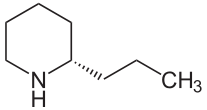Toxicity
How bad could it be?
Conium maculatum is a poisonous plant that can cause injury or death when it is
introduced into the body of another organism. Studies have revealed that Conium
maculatum has at least five recognizably different alkaloids present which includes
lambda-coniceine, coniine, N-methyl coniine, conhydrine and pseudoconhydrine.
There is also a difference in which alkaloid is more predominant in the plant
depending on a few different circumstances. Various factors such as the
developmental stage of the plant, which part of the plant is being analyzed and
where the plant is geographically located all play a role in determining the different
concentrations of these alkaloids in the plant.
Throughout the duration of this plant's vegetative growth, lambda-coniceine is of
the strongest concentration. However, when the plant matures and begins to fruit,
coniine and N-methyl coniine prevail. The entire plant is considered poisonous but
throughout the plant's growth, these alkaloids tend to mass in the seeds, fruits,
leaves and stem of the plant, with the seeds containing the highest concentration of
the poison. The peak of this poisonous concentration occurs right before the seeds
Pictured to the right is the chemical composition of
coniine. Coniine is a robust alkaline oil that has no
visible color and is quite volatile. C. maculatum contains
piperidine alkaloids that are made by the combination of an eight carbon chain that
comes from four acetate units.
Symptoms of Hemlock Poisoning
Once ingested, Conium maculatum can cause some pretty nasty side effects! A
victim may feel nervousness and have problems with movement as they begin to
tremble. As you look into the eyes of a victim, their pupils may appear dilated and
you may notice a major increase in their breathing rate. Nausea, a decrease in
body temperature, an increase in frequency of urination and convulsions may
become apparent as well. Paralysis starts to occur at the legs of the victim and then
travels upwards in the body until death occurs. The cause of death is that of
respiratory failure and this all occurs while the victim is still conscious too!
Back to Home Forward to Contact Me

